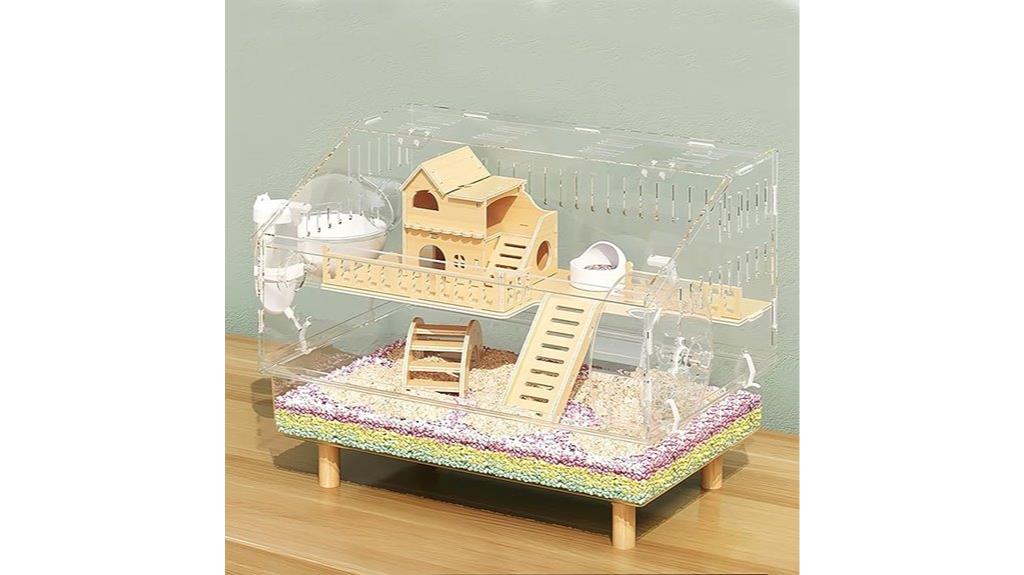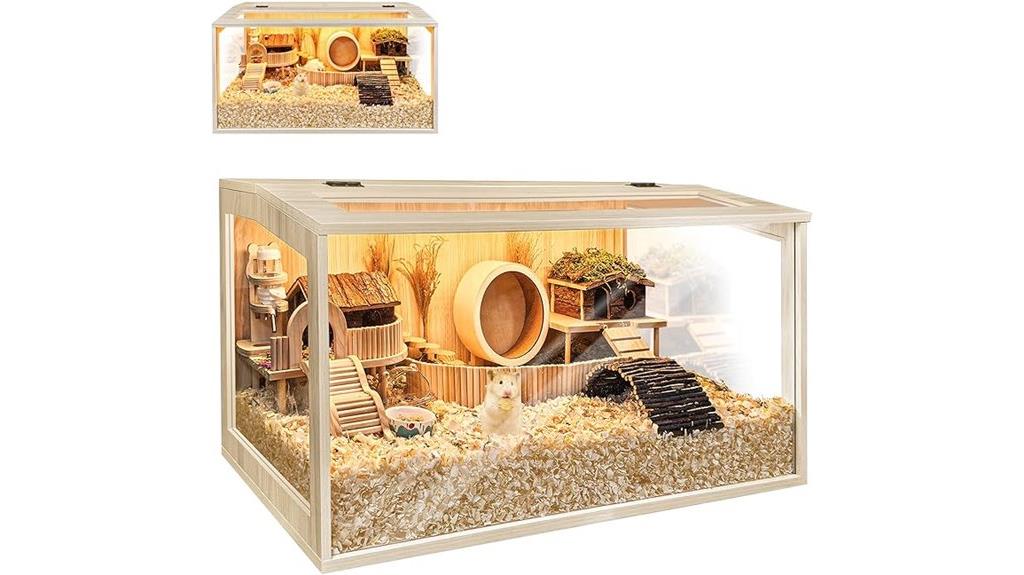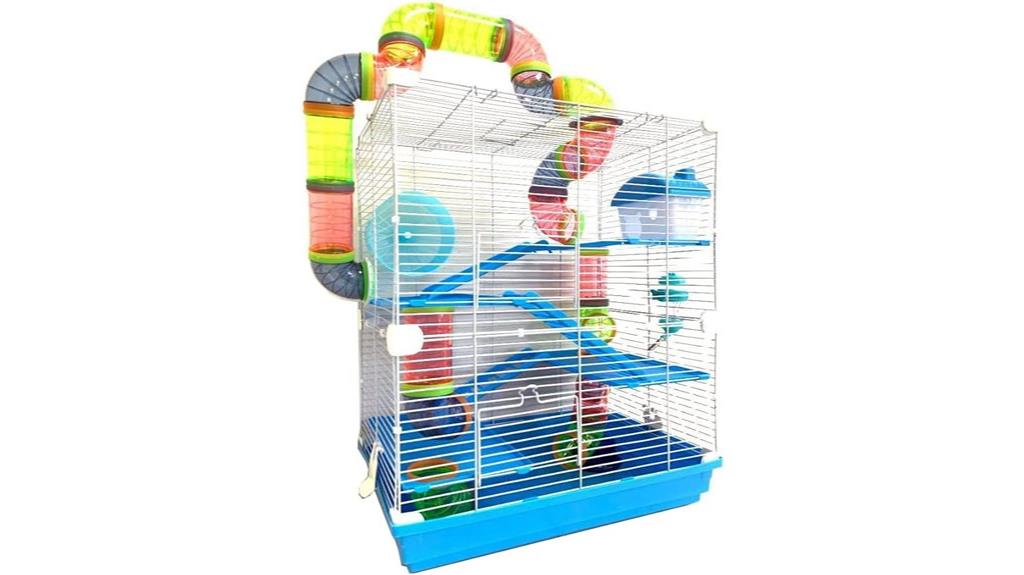You’ll want a hamster cage that’s more than just a box—it’s their entire world. Top picks for 2025 include the 8-in-1 Acrylic Cage with crystal-clear views, the robust Wooden Cage with polyester-coated protection, and the Multi-Level Blue Cage offering five floors of exploration. Each provides spacious living, escape-proof design, and essential accessories to keep your furry friend happy and healthy. Curious about which one suits your tiny companion best?
Key Takeaways
- The Acrylic Transparent Cage offers superior visibility and modern design, providing hamsters with a spacious and unobstructed living environment with multiple essential accessories.
- The Wooden Multi-Level Cage delivers robust construction with polyester-coated chewproof materials, featuring expandable platforms and transparent panels for optimal hamster habitat customization.
- Size matters critically: Minimum recommended cage dimensions are 24×12 inches for dwarf hamsters and 30×15 inches for Syrian hamsters, ensuring sufficient living space.
- High-quality hamster cages prioritize escape-proof configurations with tight bar spacing, secure locking mechanisms, and proper ventilation to maintain hamster health and safety.
- Essential cage features include sturdy exercise wheels, multiple enrichment accessories, appropriate substrate depth, secure ladders, and strategically designed platforms for natural hamster behaviors.
8-in-1 Acrylic Hamster Cage with Transparent Viewing and Accessories

If you’re searching for a versatile and visually appealing hamster habitat that combines functionality with style, the 8-in-1 Acrylic Hamster Cage stands out as an exceptional choice. Its full transparent viewing and high-quality acrylic material let you watch your furry friend’s every move. With a top-open design, easy-to-clean detachable tray, and built-in anti-escape button, this cage guarantees both pet safety and owner convenience. The included accessories—wooden house, food bowl, wheel, toys, and water bottle—provide everything your hamster needs for a comfortable home.
Best For: Pet owners seeking a comprehensive, visually appealing, and functional habitat for small rodents like hamsters, gerbils, and mice.
Pros:
- Full transparent acrylic design allows complete visibility of pet’s activities
- Includes all essential accessories for immediate setup and pet comfort
- Top-open and detachable design enables easy cleaning and maintenance
Cons:
- May be more expensive compared to traditional wire or plastic cages
- Requires careful handling of acrylic material to prevent scratches
- Protective film must be removed before use, which might be inconvenient for some buyers
https://www.amazon.com/dp/B0F527M6Y4
Hamster Wooden Cage with Acrylic Sheets for Guinea Pigs and Rodents

Pet owners seeking a versatile and durable habitat for small rodents will find the Hamster Wooden Cage with Acrylic Sheets an exceptional choice for guinea pigs, hamsters, and other small pets. Its chewproof design with polyester coating and high-density natural wood guarantees long-lasting durability. You’ll appreciate the transparent acrylic panels that provide clear visibility and easy cleaning. With four size options ranging from 24 to 48 inches, the cage offers ample space for bedding, burrowing, and exploration. The lightweight construction, openable top, and additional viewing window make this cage both functional and convenient for you and your small pet.
Best For: Pet owners looking for a spacious, durable, and easy-to-clean wooden cage for small rodents like hamsters and guinea pigs.
Pros:
- Chewproof design with polyester coating ensures long-lasting durability
- Multiple size options (24-48 inches) to accommodate different pet needs
- Transparent acrylic panels provide excellent visibility and easy maintenance
Cons:
- Relatively heavy at 14.3 lbs compared to some plastic cages
- May require more assembly effort compared to pre-assembled cages
- Higher price point due to high-quality wood and acrylic construction
https://www.amazon.com/dp/B0BBV8KYST
Large 5-Floors Blue Hamster Cage with Accessories

Hamster enthusiasts seeking a multi-level habitat will find the Mcage 5-Floors Blue Hamster Cage an expansive solution for their small animal’s living space. With five solid paw-safe floors and four ladders, this blue and white cage provides ample room for hamsters, mice, gerbils, and rats. You’ll appreciate the included accessories like a water bottle, play tubes, food bowl, hide house, and 5-inch exercise wheel. The expandable design allows for future upgrades, while its 20 x 12 x 28-inch dimensions offer plenty of space. Just be mindful of some customer feedback about potentially flimsy platforms and a noisy wheel.
Best For: Small animal owners looking for a spacious, multi-level cage with built-in accessories for hamsters, mice, gerbils, or rats.
Pros:
- Expansive 5-floor design with multiple levels for active small pets
- Comes with comprehensive accessories including water bottle, play tubes, and exercise wheel
- Easy setup with no tools required and expandable design
Cons:
- Some customers report platforms feeling flimsy
- Wheel may be noisy during nighttime use
- Hide house reported as relatively small by some reviewers
https://www.amazon.com/dp/B08F9HP6WV
Factors to Consider When Choosing Hamster Cages
When selecting a hamster cage, you’ll want to prioritize several key factors that directly impact your pet’s health and happiness. Size is indispensable, as hamsters need ample space to move, play, and explore, while robustness guarantees the cage can withstand daily wear and tear. Look for well-ventilated designs with easy-to-clean surfaces and secure configurations that prevent your tiny escape artist from finding unintended exits.
Size Matters Most
Because cage size markedly affects a hamster’s quality of life, selecting the right enclosure is critical for responsible pet ownership. You’ll want to guarantee your furry friend has ample space to burrow, nest, and exercise comfortably.
Different hamster breeds require specific cage dimensions. Dwarf hamsters need a minimum 24 x 12-inch habitat, while Syrian hamsters demand at least 30 x 15 inches. Experts recommend a 24-gallon cage volume for a single hamster, with an additional 12 gallons for each companion.
Cramped living spaces can trigger stress, behavioral problems, and potential health issues. By prioritizing spaciousness, you’re not just providing a home—you’re creating an environment that supports your hamster’s natural instincts and overall well-being.
Material Durability Counts
While durability might seem like a secondary consideration, the material of your hamster’s cage directly impacts its safety and longevity. You’ll want to choose a cage that can withstand your hamster’s natural chewing instincts and provide a secure environment.
Acrylic and wooden cages offer superior durability, effectively resisting gnawing and preventing potential escape attempts. Avoid plastic cages, which become brittle and can easily break down over time. Metal wire cages pose risks, as hamsters can chew through bars, potentially causing injury.
When selecting a cage, prioritize non-toxic materials that are escape-proof and robust. Your hamster’s safety depends on a well-constructed home that can endure constant interaction and exploration. Invest in a high-quality cage that protects your furry friend while providing a comfortable living space.
Ventilation Prevents Health Issues
Beyond material durability, a hamster’s health hinges on the quality of air circulating through its living space. You’ll want to prioritize cages with multiple ventilation holes and mesh panels that promote efficient airflow. Poor ventilation can quickly turn a cozy habitat into a hazardous environment, potentially causing respiratory infections, eye irritation, and other serious health complications.
When selecting a cage, look for designs that offer thorough air circulation. Perforated sides and strategic ventilation zones will help prevent moisture buildup and eliminate harmful ammonia gases from waste. Well-ventilated enclosures guarantee your hamster breathes clean, fresh air, supporting its overall respiratory health and wellbeing. Don’t compromise on ventilation – it’s a critical factor in maintaining a safe, comfortable home for your furry friend.
Easy Cleaning Design
How often have you dreaded the tedious task of cleaning a pet’s habitat? When choosing a hamster cage, prioritize designs that simplify maintenance. Look for top-open cages with detachable components that provide convenient access. Removable trays or bottoms make waste removal and disinfecting a breeze. Opt for smooth, non-porous materials like acrylic or glass that won’t trap odors and wipe clean easily. Large doors and well-placed ventilation holes guarantee you can thoroughly clean every corner of the enclosure. A cage with smart cleaning features will save you time and frustration, making habitat maintenance less of a chore. Your hamster deserves a clean home, and you deserve a hassle-free cleaning process.
Escape-Proof Configuration
After ensuring your hamster’s habitat is easy to clean, you’ll want to focus on another critical aspect of cage selection: preventing escape. Choose cages with chew-proof materials and tight bar spacing no wider than 0.5 inches to keep your furry friend secure. Look for robust locking mechanisms on doors and access points that can withstand your hamster’s persistent attempts to explore beyond their habitat.
Carefully evaluate the cage’s design, ensuring elevated platforms have high barriers to discourage climbing. Smooth, well-ventilated walls without loose components reduce potential escape routes. Pay attention to construction details like seamless joints and sturdy materials that prevent your clever companion from finding weak spots. A truly escape-proof cage provides peace of mind and keeps your hamster safely contained.
Appropriate Accessory Inclusion
While selecting the perfect hamster cage, you’ll quickly discover that appropriate accessory inclusion is more than just an afterthought—it’s a critical component of creating a healthy, stimulating environment for your small companion. Your hamster’s habitat needs essential items like a sturdy water bottle, appropriately sized food bowl, and an exercise wheel that supports natural movement.
Consider adding diverse enrichment items such as tunnels, ladders, and chew blocks that promote foraging and exploratory behaviors. Soft, safe substrate allows burrowing and satisfies digging instincts, while mesh or perforated panels guarantee proper ventilation. Always prioritize accessories that are non-toxic, chew-proof, and specifically designed for hamster safety. By thoughtfully selecting these components, you’ll create a cage that’s not just a living space, but a dynamic, engaging home.
Multiple Floor Levels
Because multi-level hamster cages offer expanded living spaces, they’ve become increasingly popular among pet owners seeking to maximize habitat enrichment. You’ll want to carefully consider your hamster’s specific breed and activity level when selecting a multi-floor design. Guarantee platforms and ladders are sturdy and securely installed to prevent potential falls or escape attempts.
While these vertical spaces provide exciting exploration opportunities, they also present challenges. You’ll need to balance the number of floors with your hamster’s size and mobility. Pay close attention to ventilation and cleaning requirements, as taller cages demand more maintenance. Use appropriate bedding depths and platform barriers to create a safe, comfortable environment that allows your furry friend to play, climb, and thrive in their multilevel home.
Cost-Value Relationship
When shopping for a hamster cage, understanding the cost-value relationship becomes pivotal for responsible pet ownership. You’ll want to balance initial price with long-term functionality, recognizing that cheaper isn’t always more economical. Higher-priced cages often provide better ventilation, more space, and additional accessories that can enhance your hamster’s quality of life.
Consider the cage’s construction and materials carefully. A well-built cage might cost more upfront but can prevent potential veterinary expenses later. Don’t just focus on the purchase price; factor in ongoing costs like bedding, food bowls, and potential replacements. By evaluating these elements, you’ll make a more informed decision that prioritizes your hamster’s comfort and your budget’s sustainability.
Frequently Asked Questions
How Often Should I Clean My Hamster’s Cage?
You’ll want to clean your hamster’s cage thoroughly once a week. Spot clean daily by removing soiled bedding and uneaten food to maintain hygiene. Use this weekly deep clean as an opportunity to replace all bedding, wash food and water containers, and disinfect cage surfaces. Don’t forget to provide fresh bedding and guarantee your furry friend has a clean, comfortable living space.
Can Hamsters Live Together in the Same Cage?
Generally, you shouldn’t keep hamsters together in the same cage. Most hamster species are solitary and territorial, which means they’ll fight if housed together. Syrian hamsters are especially aggressive and will seriously harm each other. Even dwarf hamsters, which seem more social, can become violent. You’ll want to house your hamsters separately to prevent injury and guarantee their safety and well-being.
What Type of Bedding Is Safest for Hamsters?
You’ll want to choose bedding that’s soft, absorbent, and safe for your hamster. Paper-based beddings like Carefresh or recycled paper products are excellent choices. Avoid cedar or pine shavings, as they can cause respiratory issues. Aspen wood shavings are a good alternative. Don’t use cotton or fluffy beddings that can tangle around your hamster’s limbs. Always opt for unscented, dust-free options to keep your furry friend healthy and comfortable.
Do Hamsters Need Special Ventilation in Their Cages?
Yes, you’ll want proper ventilation for your hamster’s health. Good airflow prevents moisture buildup and reduces the risk of respiratory issues. Look for cages with multiple wire sides or mesh panels that allow air circulation. Don’t seal your hamster in a completely enclosed space, as this can lead to stale air and potential breathing problems. Guarantee your pet’s habitat has adequate breathing room.
How Big Should a Hamster Cage Be?
Like a tiny kingdom needs ample space to thrive, your hamster requires room to roam. You’ll want a cage that’s at least 24 x 12 inches and 12 inches tall, providing a minimum of 360 square inches of floor space. Don’t skimp on size—hamsters are active creatures that need areas for burrowing, playing, and exercising. A spacious habitat guarantees your furry friend stays happy and healthy.
Conclusion
You’ve explored the top hamster habitats that’ll make your furry friend’s home a palace. From acrylic wonders to multi-level wooden retreats, these cages aren’t just shelters—they’re kingdoms where your hamster can reign supreme. Like a telegraph operator signaling joy, these living spaces communicate comfort, safety, and love. Choose wisely, and you’ll create a sanctuary that transforms your tiny companion’s world into an adventure.

Maria is brilliant when it comes to creating beautiful and functional spaces. Maria has an exceptional ability to understand your needs and desires, translating them into tailored solutions that reflect your personality and lifestyle. Whether you’re seeking advice on home decor, looking to upgrade your interior, or seeking inspiration to enhance your quality of life through design, Maria can help you achieve your goals. With Maria by your side, your vision for the perfect home is within reach.
